Jiale Tao
PromptEnhancer: A Simple Approach to Enhance Text-to-Image Models via Chain-of-Thought Prompt Rewriting
Sep 04, 2025Abstract:Recent advancements in text-to-image (T2I) diffusion models have demonstrated remarkable capabilities in generating high-fidelity images. However, these models often struggle to faithfully render complex user prompts, particularly in aspects like attribute binding, negation, and compositional relationships. This leads to a significant mismatch between user intent and the generated output. To address this challenge, we introduce PromptEnhancer, a novel and universal prompt rewriting framework that enhances any pretrained T2I model without requiring modifications to its weights. Unlike prior methods that rely on model-specific fine-tuning or implicit reward signals like image-reward scores, our framework decouples the rewriter from the generator. We achieve this by training a Chain-of-Thought (CoT) rewriter through reinforcement learning, guided by a dedicated reward model we term the AlignEvaluator. The AlignEvaluator is trained to provide explicit and fine-grained feedback based on a systematic taxonomy of 24 key points, which are derived from a comprehensive analysis of common T2I failure modes. By optimizing the CoT rewriter to maximize the reward from our AlignEvaluator, our framework learns to generate prompts that are more precisely interpreted by T2I models. Extensive experiments on the HunyuanImage 2.1 model demonstrate that PromptEnhancer significantly improves image-text alignment across a wide range of semantic and compositional challenges. Furthermore, we introduce a new, high-quality human preference benchmark to facilitate future research in this direction.
Hunyuan-Game: Industrial-grade Intelligent Game Creation Model
May 20, 2025Abstract:Intelligent game creation represents a transformative advancement in game development, utilizing generative artificial intelligence to dynamically generate and enhance game content. Despite notable progress in generative models, the comprehensive synthesis of high-quality game assets, including both images and videos, remains a challenging frontier. To create high-fidelity game content that simultaneously aligns with player preferences and significantly boosts designer efficiency, we present Hunyuan-Game, an innovative project designed to revolutionize intelligent game production. Hunyuan-Game encompasses two primary branches: image generation and video generation. The image generation component is built upon a vast dataset comprising billions of game images, leading to the development of a group of customized image generation models tailored for game scenarios: (1) General Text-to-Image Generation. (2) Game Visual Effects Generation, involving text-to-effect and reference image-based game visual effect generation. (3) Transparent Image Generation for characters, scenes, and game visual effects. (4) Game Character Generation based on sketches, black-and-white images, and white models. The video generation component is built upon a comprehensive dataset of millions of game and anime videos, leading to the development of five core algorithmic models, each targeting critical pain points in game development and having robust adaptation to diverse game video scenarios: (1) Image-to-Video Generation. (2) 360 A/T Pose Avatar Video Synthesis. (3) Dynamic Illustration Generation. (4) Generative Video Super-Resolution. (5) Interactive Game Video Generation. These image and video generation models not only exhibit high-level aesthetic expression but also deeply integrate domain-specific knowledge, establishing a systematic understanding of diverse game and anime art styles.
InstantCharacter: Personalize Any Characters with a Scalable Diffusion Transformer Framework
Apr 16, 2025Abstract:Current learning-based subject customization approaches, predominantly relying on U-Net architectures, suffer from limited generalization ability and compromised image quality. Meanwhile, optimization-based methods require subject-specific fine-tuning, which inevitably degrades textual controllability. To address these challenges, we propose InstantCharacter, a scalable framework for character customization built upon a foundation diffusion transformer. InstantCharacter demonstrates three fundamental advantages: first, it achieves open-domain personalization across diverse character appearances, poses, and styles while maintaining high-fidelity results. Second, the framework introduces a scalable adapter with stacked transformer encoders, which effectively processes open-domain character features and seamlessly interacts with the latent space of modern diffusion transformers. Third, to effectively train the framework, we construct a large-scale character dataset containing 10-million-level samples. The dataset is systematically organized into paired (multi-view character) and unpaired (text-image combinations) subsets. This dual-data structure enables simultaneous optimization of identity consistency and textual editability through distinct learning pathways. Qualitative experiments demonstrate the advanced capabilities of InstantCharacter in generating high-fidelity, text-controllable, and character-consistent images, setting a new benchmark for character-driven image generation. Our source code is available at https://github.com/Tencent/InstantCharacter.
Learning Semantic Latent Directions for Accurate and Controllable Human Motion Prediction
Jul 16, 2024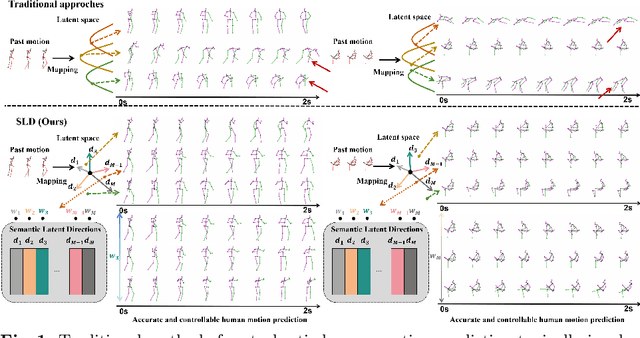
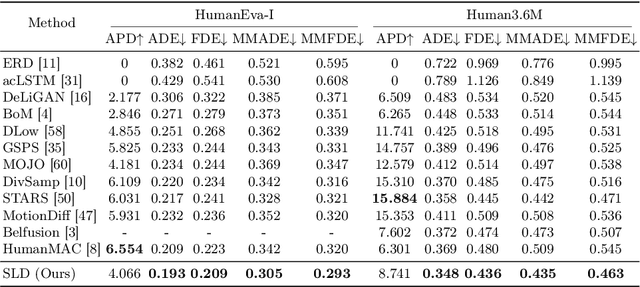
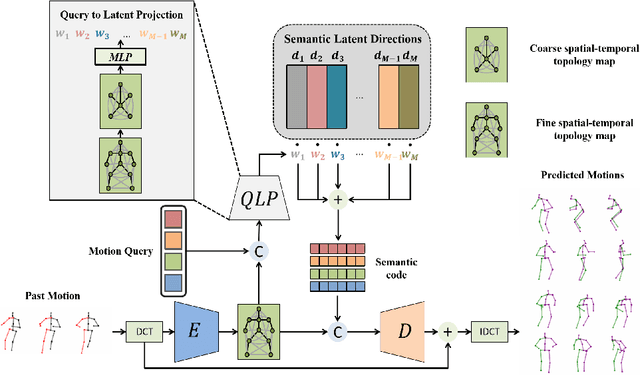

Abstract:In the realm of stochastic human motion prediction (SHMP), researchers have often turned to generative models like GANS, VAEs and diffusion models. However, most previous approaches have struggled to accurately predict motions that are both realistic and coherent with past motion due to a lack of guidance on the latent distribution. In this paper, we introduce Semantic Latent Directions (SLD) as a solution to this challenge, aiming to constrain the latent space to learn meaningful motion semantics and enhance the accuracy of SHMP. SLD defines a series of orthogonal latent directions and represents the hypothesis of future motion as a linear combination of these directions. By creating such an information bottleneck, SLD excels in capturing meaningful motion semantics, thereby improving the precision of motion predictions. Moreover, SLD offers controllable prediction capabilities by adjusting the coefficients of the latent directions during the inference phase. Expanding on SLD, we introduce a set of motion queries to enhance the diversity of predictions. By aligning these motion queries with the SLD space, SLD is further promoted to more accurate and coherent motion predictions. Through extensive experiments conducted on widely used benchmarks, we showcase the superiority of our method in accurately predicting motions while maintaining a balance of realism and diversity. Our code and pretrained models are available at https://github.com/GuoweiXu368/SLD-HMP.
Learning Motion Refinement for Unsupervised Face Animation
Oct 21, 2023Abstract:Unsupervised face animation aims to generate a human face video based on the appearance of a source image, mimicking the motion from a driving video. Existing methods typically adopted a prior-based motion model (e.g., the local affine motion model or the local thin-plate-spline motion model). While it is able to capture the coarse facial motion, artifacts can often be observed around the tiny motion in local areas (e.g., lips and eyes), due to the limited ability of these methods to model the finer facial motions. In this work, we design a new unsupervised face animation approach to learn simultaneously the coarse and finer motions. In particular, while exploiting the local affine motion model to learn the global coarse facial motion, we design a novel motion refinement module to compensate for the local affine motion model for modeling finer face motions in local areas. The motion refinement is learned from the dense correlation between the source and driving images. Specifically, we first construct a structure correlation volume based on the keypoint features of the source and driving images. Then, we train a model to generate the tiny facial motions iteratively from low to high resolution. The learned motion refinements are combined with the coarse motion to generate the new image. Extensive experiments on widely used benchmarks demonstrate that our method achieves the best results among state-of-the-art baselines.
Motion and Appearance Adaptation for Cross-Domain Motion Transfer
Oct 06, 2022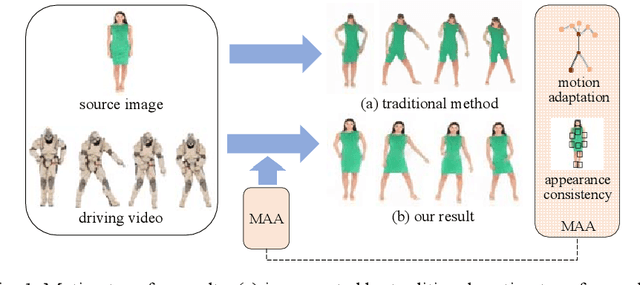
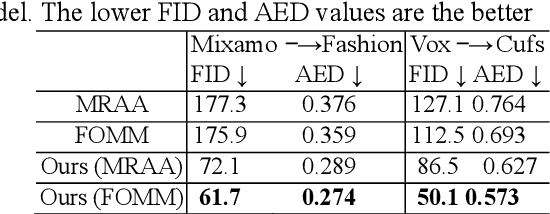
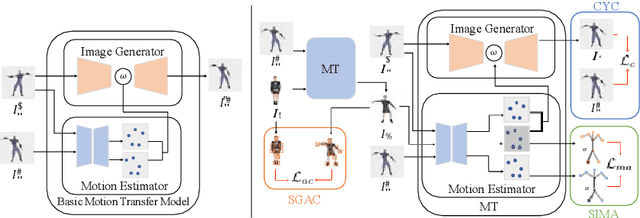
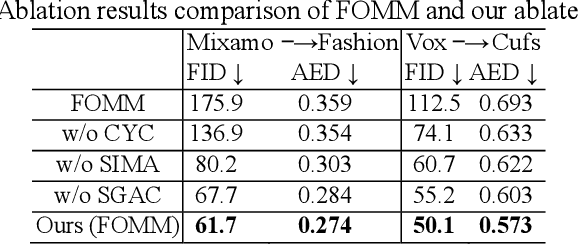
Abstract:Motion transfer aims to transfer the motion of a driving video to a source image. When there are considerable differences between object in the driving video and that in the source image, traditional single domain motion transfer approaches often produce notable artifacts; for example, the synthesized image may fail to preserve the human shape of the source image (cf . Fig. 1 (a)). To address this issue, in this work, we propose a Motion and Appearance Adaptation (MAA) approach for cross-domain motion transfer, in which we regularize the object in the synthesized image to capture the motion of the object in the driving frame, while still preserving the shape and appearance of the object in the source image. On one hand, considering the object shapes of the synthesized image and the driving frame might be different, we design a shape-invariant motion adaptation module that enforces the consistency of the angles of object parts in two images to capture the motion information. On the other hand, we introduce a structure-guided appearance consistency module designed to regularize the similarity between the corresponding patches of the synthesized image and the source image without affecting the learned motion in the synthesized image. Our proposed MAA model can be trained in an end-to-end manner with a cyclic reconstruction loss, and ultimately produces a satisfactory motion transfer result (cf . Fig. 1 (b)). We conduct extensive experiments on human dancing dataset Mixamo-Video to Fashion-Video and human face dataset Vox-Celeb to Cufs; on both of these, our MAA model outperforms existing methods both quantitatively and qualitatively.
Motion Transformer for Unsupervised Image Animation
Sep 28, 2022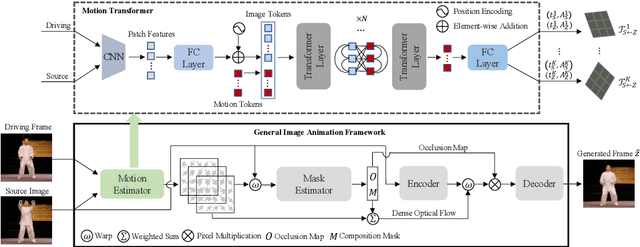
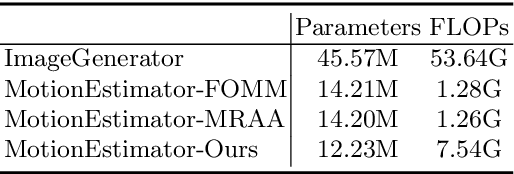


Abstract:Image animation aims to animate a source image by using motion learned from a driving video. Current state-of-the-art methods typically use convolutional neural networks (CNNs) to predict motion information, such as motion keypoints and corresponding local transformations. However, these CNN based methods do not explicitly model the interactions between motions; as a result, the important underlying motion relationship may be neglected, which can potentially lead to noticeable artifacts being produced in the generated animation video. To this end, we propose a new method, the motion transformer, which is the first attempt to build a motion estimator based on a vision transformer. More specifically, we introduce two types of tokens in our proposed method: i) image tokens formed from patch features and corresponding position encoding; and ii) motion tokens encoded with motion information. Both types of tokens are sent into vision transformers to promote underlying interactions between them through multi-head self attention blocks. By adopting this process, the motion information can be better learned to boost the model performance. The final embedded motion tokens are then used to predict the corresponding motion keypoints and local transformations. Extensive experiments on benchmark datasets show that our proposed method achieves promising results to the state-of-the-art baselines. Our source code will be public available.
Undoing the Damage of Label Shift for Cross-domain Semantic Segmentation
Apr 12, 2022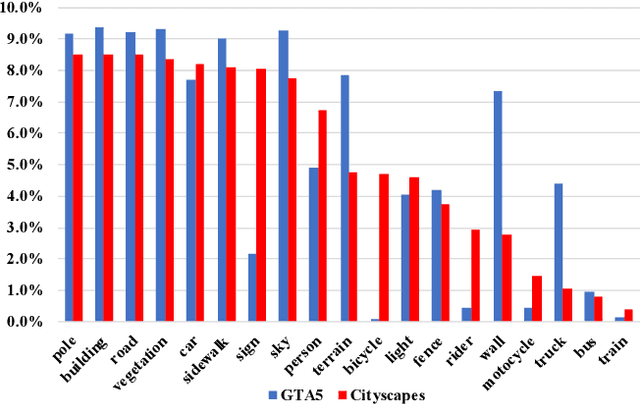
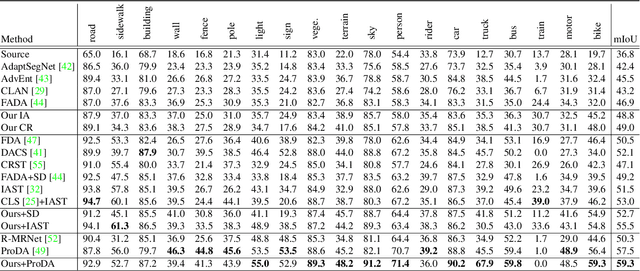
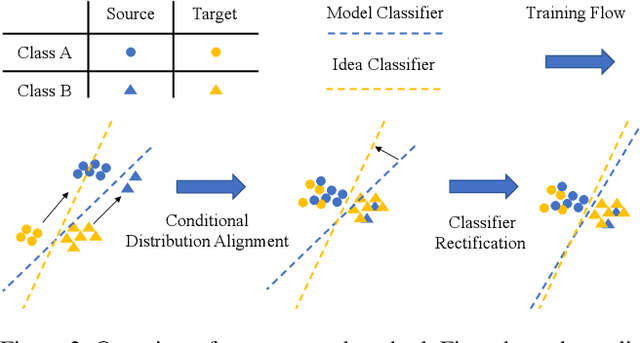
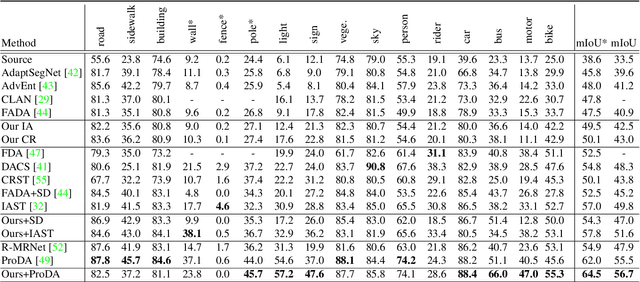
Abstract:Existing works typically treat cross-domain semantic segmentation (CDSS) as a data distribution mismatch problem and focus on aligning the marginal distribution or conditional distribution. However, the label shift issue is unfortunately overlooked, which actually commonly exists in the CDSS task, and often causes a classifier bias in the learnt model. In this paper, we give an in-depth analysis and show that the damage of label shift can be overcome by aligning the data conditional distribution and correcting the posterior probability. To this end, we propose a novel approach to undo the damage of the label shift problem in CDSS. In implementation, we adopt class-level feature alignment for conditional distribution alignment, as well as two simple yet effective methods to rectify the classifier bias from source to target by remolding the classifier predictions. We conduct extensive experiments on the benchmark datasets of urban scenes, including GTA5 to Cityscapes and SYNTHIA to Cityscapes, where our proposed approach outperforms previous methods by a large margin. For instance, our model equipped with a self-training strategy reaches 59.3% mIoU on GTA5 to Cityscapes, pushing to a new state-of-the-art. The code will be available at https://github.com/manmanjun/Undoing UDA.
Structure-Aware Motion Transfer with Deformable Anchor Model
Apr 11, 2022
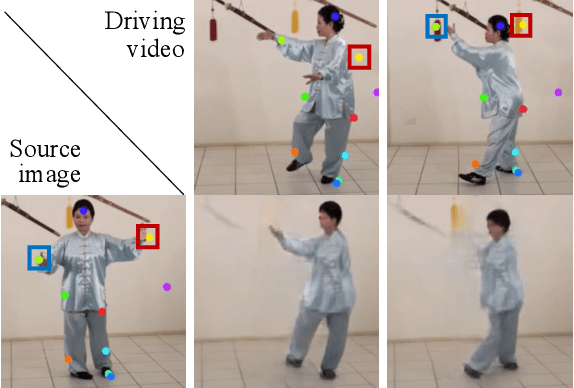

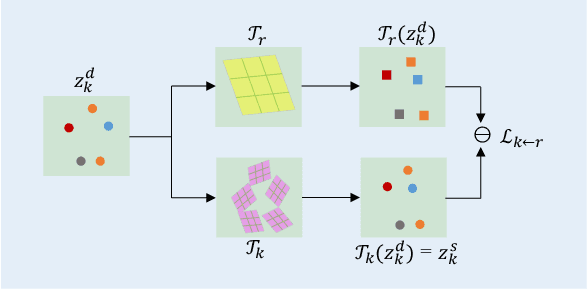
Abstract:Given a source image and a driving video depicting the same object type, the motion transfer task aims to generate a video by learning the motion from the driving video while preserving the appearance from the source image. In this paper, we propose a novel structure-aware motion modeling approach, the deformable anchor model (DAM), which can automatically discover the motion structure of arbitrary objects without leveraging their prior structure information. Specifically, inspired by the known deformable part model (DPM), our DAM introduces two types of anchors or keypoints: i) a number of motion anchors that capture both appearance and motion information from the source image and driving video; ii) a latent root anchor, which is linked to the motion anchors to facilitate better learning of the representations of the object structure information. Moreover, DAM can be further extended to a hierarchical version through the introduction of additional latent anchors to model more complicated structures. By regularizing motion anchors with latent anchor(s), DAM enforces the correspondences between them to ensure the structural information is well captured and preserved. Moreover, DAM can be learned effectively in an unsupervised manner. We validate our proposed DAM for motion transfer on different benchmark datasets. Extensive experiments clearly demonstrate that DAM achieves superior performance relative to existing state-of-the-art methods.
Move As You Like: Image Animation in E-Commerce Scenario
Dec 19, 2021

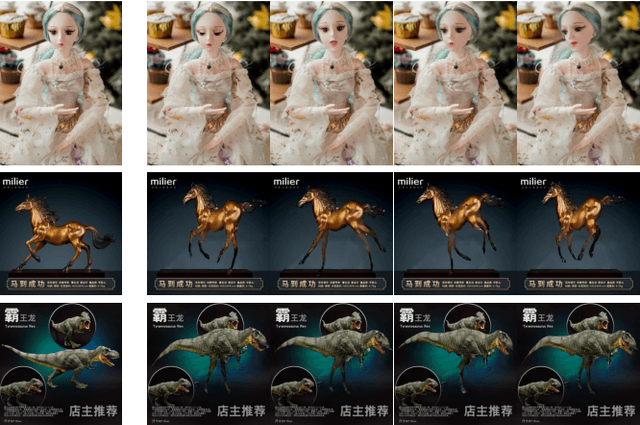
Abstract:Creative image animations are attractive in e-commerce applications, where motion transfer is one of the import ways to generate animations from static images. However, existing methods rarely transfer motion to objects other than human body or human face, and even fewer apply motion transfer in practical scenarios. In this work, we apply motion transfer on the Taobao product images in real e-commerce scenario to generate creative animations, which are more attractive than static images and they will bring more benefits. We animate the Taobao products of dolls, copper running horses and toy dinosaurs based on motion transfer method for demonstration.
* 3 pages, 3 figures, ACM MM 2021 demo session
 Add to Chrome
Add to Chrome Add to Firefox
Add to Firefox Add to Edge
Add to Edge